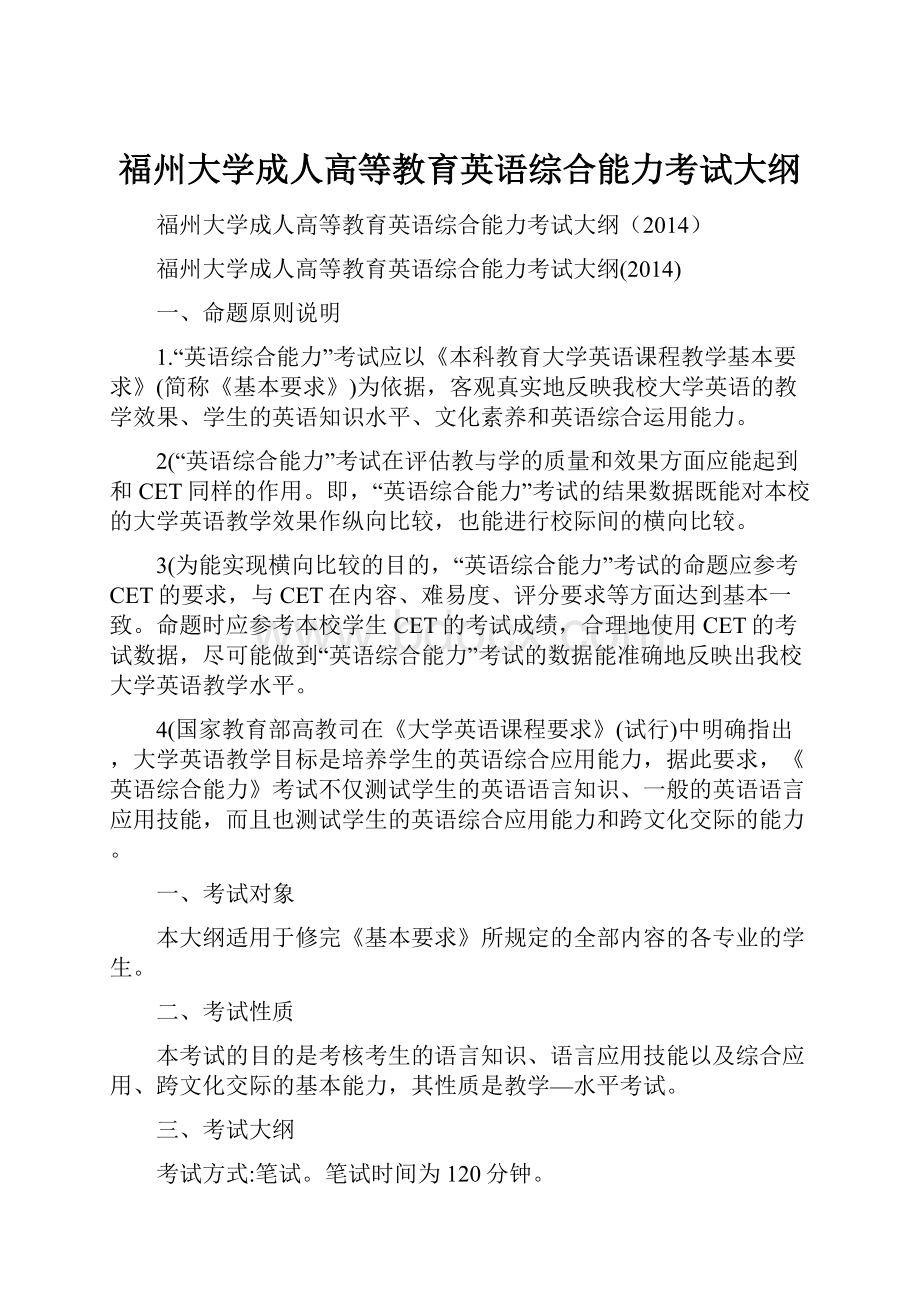福州大学成人高等教育英语综合能力考试大纲.docx
《福州大学成人高等教育英语综合能力考试大纲.docx》由会员分享,可在线阅读,更多相关《福州大学成人高等教育英语综合能力考试大纲.docx(20页珍藏版)》请在冰豆网上搜索。

福州大学成人高等教育英语综合能力考试大纲
福州大学成人高等教育英语综合能力考试大纲(2014)
福州大学成人高等教育英语综合能力考试大纲(2014)
一、命题原则说明
1.“英语综合能力”考试应以《本科教育大学英语课程教学基本要求》(简称《基本要求》)为依据,客观真实地反映我校大学英语的教学效果、学生的英语知识水平、文化素养和英语综合运用能力。
2(“英语综合能力”考试在评估教与学的质量和效果方面应能起到和CET同样的作用。
即,“英语综合能力”考试的结果数据既能对本校的大学英语教学效果作纵向比较,也能进行校际间的横向比较。
3(为能实现横向比较的目的,“英语综合能力”考试的命题应参考CET的要求,与CET在内容、难易度、评分要求等方面达到基本一致。
命题时应参考本校学生CET的考试成绩,合理地使用CET的考试数据,尽可能做到“英语综合能力”考试的数据能准确地反映出我校大学英语教学水平。
4(国家教育部高教司在《大学英语课程要求》(试行)中明确指出,大学英语教学目标是培养学生的英语综合应用能力,据此要求,《英语综合能力》考试不仅测试学生的英语语言知识、一般的英语语言应用技能,而且也测试学生的英语综合应用能力和跨文化交际的能力。
一、考试对象
本大纲适用于修完《基本要求》所规定的全部内容的各专业的学生。
二、考试性质
本考试的目的是考核考生的语言知识、语言应用技能以及综合应用、跨文化交际的基本能力,其性质是教学—水平考试。
三、考试大纲
考试方式:
笔试。
笔试时间为120分钟。
笔试内容:
语言知识和听、读、写等技能
客观性试题有信度较高、覆盖面广的优点,而主观性试题有利于提高测试的效度,能更好地检测考生运用语言的能力,为此本考试采用主客观混合题型,以保证良好的信度和效度。
本考试按百分制计分,满分为100分。
其中听力15分,阅读30分、词汇与语法30分、完型填空10分,写作15分。
笔试
1(听力理解(ListeningComprehension)
测试考生运用基本的听力技巧理解所听对话、会话和简单短文或复合式听写的能力。
听力材料的语速为每分钟130个词,能掌握其中心大意、抓住要点。
本部分的得分占总分的15%。
测试时间为15分钟。
2(阅读理解(ReadingComprehension)
测试考生运用有效的阅读技巧基本读懂一般性题材的英文文章,阅读速度达到每分钟70个词;在快速阅读篇幅较长、难度略低的材料时,阅读速度达到每分钟100个词;能基本读懂国内英文报刊,掌握中心意思,理解主要事实和有关细节;能读懂工作、生活中常见的应用文体的材料。
本部分的得分占总分的30%。
测试时间为35分钟。
3(词汇用法与语法结构(VocabularyandStructure)
测试考生正确运用词汇、短语和语法知识的能力。
测试范围包括《基本要求》所规定的“掌握的词汇达到4500个单词和700个词组”,其中2000个单词为积极词汇。
本部分的得分占总分的30%。
测试时间为25分钟。
4.完型填空(Cloze)
完型填空部分的目的是测试学生综合运用语言的能力,也即理解篇章和使用词汇和语法
1
的能力。
考试采用的完型填空题是:
“在一篇题材熟悉、难度适中的短文(约200-250词)内
留有20个空白,每个空白为一题,每题有四个选择项,要求考生在全面理解内容的基础上选
择一个最佳答案,使短文的意识和结构恢复完整”。
本部分的得分占总分的10%。
测试时间为15分钟。
4(写作(Writing)
写作测试考生运用基本的写作技能进行一般性的写作;能写常见的应用文、说明文、描
写文、议论文等;能就一般性话题或提纲在半小时内写出120个词的短文,内容基本完整,
用词恰当,语意连贯。
本部分的得分占总分的15%。
测试时间为30分钟。
考试参考用书:
1.《大学英语自主测试题四级》复旦大学出版社出版,2011年12月主编:
王平
2.《大学英语四级考试710分快速突破写作》外研社出版,2009年9月总主编:
方振宇
福州大学外国语学院大学英语教学部
2013年9月
大学英语综合能力考试样题(笔试)和答案
ComprehensiveEnglishTestForColleges(SampleTest)
PartIListeningComprehension(15minutes,15%)
SectionA
Directions:
Inthispart,youwillhear10shortconversations.Attheendofeachconversation,aquestionwillbeaskedaboutwhatwassaid.Boththeconversationandthequestionwillbespokenonlyonce.Aftereachquestiontherewillbeapause.Duringthepause,youmustreadthefourchoicesmarkedA),B),C)andD),anddecidewhichisthebestanswer.ThenmarkthecorrespondingletterontheAnswerSheetwithasinglelinethroughthecenter.
Example:
Youwillhear:
M:
Isitpossibleforyoutoworklate,MissGrey?
W:
Worklate?
Isupposeso,ifyoureallythinkitisnecessary.
Q:
Wheredoyouthinkthisconversationmostprobablytookplace?
Youwillread:
A)Attheoffice.B)Inthewaitingroom.
C)Attheairport.D)Inarestaurant.
Fromtheconversationweknowthatthetwoweretalkingaboutsomeworktheyhavetofinishin
theevening.Thisismostlikelytohavetakenplaceattheoffice.Therefore,“A)”attheoffice.”is
thebestanswer.Youshouldchoosetheletter“A)”ontheAnswerSheetandmarkitwithasinglelinethroughthecenter.
2
1.A)Shewon’tdofavorsforothers.
B)She’llreturnthebookonherwaytowork.
C)Shecan’treturnthebookfortheman.
D)Sheworksattheschoollibrary.
2.A)Themanandthewomanusedtohateeachother.B)Themanandthewomanusedtoloveeachother.C)Themanandthewomanarestillonfriendlyterms.D)Themanandthewomanareteachingeachotheralot.3.A)Thewomandidn’tliketheparty.
B)Themandidn’tgototheparty.
C)Themanenjoyedtheparty.
D)Thewomanmissedtheparty.
4.A)Itisgoodforhisthroatbutnothiscough.B)Itisgoodforhiscoughbutnothisthroat.C)Itisgoodforbothhisthroatandhiscough.
D)Itisn’tgoodforeitherhisthroatorhiscough.5.A)8a.m.to9p.m.
B)9a.m.to5p.m.
C)5a.m.to9p.m.
D)closed.
6.A)Becalmandpatient.
B)ListencarefullytoJohn.
C)Dotheeasiestthing.
D)WorkwithJohn.
7.A)Abookaboutscience.
B)Alovelystory.
C)Agoodpay.
D)Ascience-fictionfilm.
8.A)Hehasretired.
B)Hehasgoneforabusiness.
C)Hehasfallenill.
D)Hehasbeenlateforwork.
9.A)Shedoesn’twanttohelphim.
B)Shedoesn’thavetimetohelphim.
C)She’safraidshecan’tbeofmuchhelp.
D)Hewouldtrytodoitonhisown.
10.A)Hewantssomeinformationaboutthehouse.
B)HeplantstoworkinGreen’soffice.
C)Heneedstheadvertisement.
D)HewantsToday’sDaily.
SectionB
Directions:
Inthissection,youwillhear2shortpassages.Attheendofeach
passage,youwillhearsomequestions.Boththepassagesandthequestionswillbe
3
spokenonlyonce.Afteryouhearaquestion,youmustchoosethebestanswerfromthefourchoicesmarkedA),B),C)andD).ThenmarkthecorrespondingletterontheAnswerSheetwithasinglelinethroughthecenter.
PassageOne
Questions11to13arebasedonthepassageyouhavejustheard.
11.A)Nine.
B)Nineteen.
C)Ninety
D)Ninety-one
12.A)Shehelpedthemtofindjobsinfactories.
B)Sheplayedwiththemonthestreet.
C)ShehelpedthemtobeeducatedandcaredforinKindergartensandnurseries.
D)Shewrotenewlawstoprotectthem.
13.A)ThedifficultlifeforimmigrantsinChicago.
B)Children’spre-schooleducationinChicago.
C)JaneAddams’struggleforwoman’srights.
D)ThecontributionsofJaneAddamstosociety.
PassageTwo
Questions14to15arebasedonthepassageyouhavejustheard.
14.A)Becauseindustryinbigcitiesisdeveloping.
B)Becausethebirthrateinbigcitiesisrising.
C)Becausemoreandmorepeoplemovefrombigcitiestosmalltowns.
D)Becausemoreandmorepeoplemovetobigcities.
15.A)Becausebigcitiesaresaferthansmalltowns.
B)Becausebigcitiesgivepeoplemoreadvantagesthansmalltownsdo.
C)Becausepeoplewereborninbigcities.
D)Becausethereishousingshortageinsmalltowns.
PartIIReadingComprehension(35minutes,30%)
Directions:
Readthefollowingpassagesandchoosethebestanswertoeachofthequestions
followingthepassage.
Questions16to20arebasedonthefollowingpassage:
Whydostudentscutclassessofrequently?
Icancitetheimmediatecauses,butIfirstwanttonotethattheycancutbecausetheyareallowedto.Theycutbecauseoftheclimateofacceptancethatcomesfromourbeliefthatresponsibilitycanbedevelopedonlywhenoneisfree,freeeventoactagainstpersonalbestinterests.Thatthatisamisappliedbeliefinthiscasecanbeeasily
demonstrated.Whensubstantialnumbersofstudentsdonotattend,classroomlearningisdepreciated(贬低),studentandteachermoralesuffers,andacademicstandardsarecompromised.Studentswhomissclassesunnecessarilyarehurtingmorethanthemselves.Theyareunderminingwhatcollegesanduniversitiesareallabout.
Studentscutfortwogeneralreasons.Theyhavethingstodothatappearmoreimportantthantheclass,ortheywishtoavoidwhattheyfearwillbepainfulconsequencesiftheyattend.Inregardtothefirst,nursinganillnessorattendingfamilyweddingsaregoodexcusesformissingaclass.
4
Butotherexcuses—thedemandsofoutsidejobs,socialengagements(includingrecoveringfromthenightbefore),completingassignmentsforothercourses—are,atbest,questionable.
Theothergeneralreasonismoredisturbingandperhapslesswellrecognized.Afewyearsago,Iaskedseveralclasseswhattheymostdislikedaboutthewaycoursesweretaught,andtheanswer
anythingthatproducedsustainedtensionoranxiety.Ibelievecuttingisoftenaresultofwasplain—
thataversion.Theresponseofstudentstofeelingsofpersonalinadequacy,fearofhumiliation,orathreateningprofessorialpersonalityorteachingstyleisoftensimplytoavoidclass.Thisresponsefeedsonitself,asfrequentabsencesmakeattendingevenmorethreatening.
Butwhataccountsforfrequentcuttingwheretheteachertriestomakethematerialinteresting,knowsthestudentsbyname,andapproachesthemwithrespectandhelp?
Iacceptthatquestionsasunanswerable.Isimplytellmystudents:
Attendmyclassesregularlyordropthecourse.That’stherule.
16.Theword“that”(Line4,Para.1)refersto__________.
A)theimmediatecausesofthestudents’absencefromclasses
B)theauthor’sbeliefthatstudentsarepermittedtocutclasses
C)teachers’toleranceofthestudentswhorarelyshowupintheclassroom
D)thebeliefthatfreedomisessentialincultivatingasenseofresponsibility17.Whydouniversitystudentssooftenmissclasses?
A)Theyareadvisedtorestuntiltheyrecoverfromtheirillnesses.
B)Theywanttoavoidpainfulfeelingsbroughtbytheprofessors.
C)Theinadequateallowancestheygetforcethemtotakepart-timejobs.
D)Theythinktheteachingqualificationsoftheprofessorsareopentoquestion.18.Theword“aversion”(Line4,Para.3)means__________.
A)responseB)dislike
C)excuseD)plainness
19Whatistheresultofthestudents’frequentcutting?
A)Theyarelikelytoavoidmoreclasses.
B)Theyhavetolowertheiracademicstandards.
C)Theyareinvolvedinmoresocialactivities.
D)Theyattachlessimportancetoclassroomlearning.
20.Whatistheauthor’sattitudetowardsstudentswhooftencutclasses?
A)Indifferent.B)Regretful.
C)Negative.D)Cautious.
Questions21to25arebasedonthefollowingpassage:
Asubjectwhichseemstohavebeeninsufficientlystudiedbydoctorsandpsychologistsistheinfluenceofgeographyandclimateonthepsychologicalandphysicalhealthofhumankind.Thereseemsnodoubtthatthegeneralcharacteroflandscape,therelativelengthofdayandnight,andclimatemustallplayapartindeterminingwhatkindofpeopleweare.
Itistruethatafewstudieshavebeenmade.Wherealltheinhabitantsofaparticul